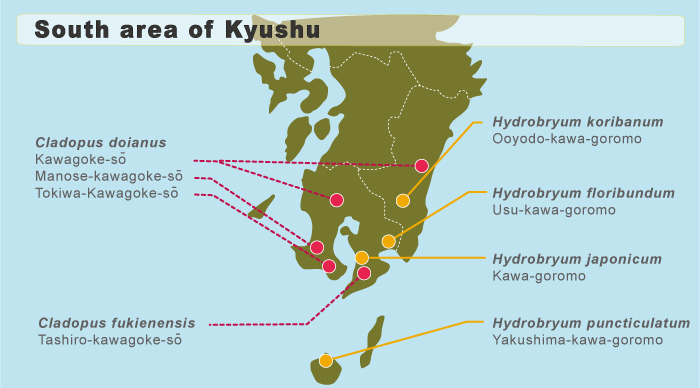>>index
PODOSTEMACEAE IN JAPAN
 Two genera and six species occur in the southern part of Kyushu (Miyazaki and Kagoshima prefectures). Some species are endemic to Japan, and the others are also distributed in eastern China (Cladopus) or southwestern China and northen Thailand (Hydrobryum). In Japan most species are restricted to particular sites in some rivers.
Two genera and six species occur in the southern part of Kyushu (Miyazaki and Kagoshima prefectures). Some species are endemic to Japan, and the others are also distributed in eastern China (Cladopus) or southwestern China and northen Thailand (Hydrobryum). In Japan most species are restricted to particular sites in some rivers.
Hydrobryum: Stamens 2, forked from common andropod; capsules ellipsoid, compressed, ribbed, appressed to rocks; bracts boat-shaped, entire; roots crustose, with tufts of linear leaves scattered on dorsal surface.Cladopus: Stamen 1, simple; capsules globose, smooth, erect; bracts digitate, surface rough; roots compressed, subcylindrical or ribbon-like, with tufts of leaves at sinuses of root branches.

Key to the Japanese species of Podostemaceae
Hydrobryum
1. Stamens 2, forked from common andropod; capsules ellipsoid, compressed, ribbed, appressed to rocks; bracts boat-shaped, entire; roots crustose, with tufts of linear leaves scattered on dorsal surface.
2. Roots thin (0.1–0.2 mm)
.......... Hydrobryum floribundum2. Roots thick (0.2–0.5 mm)
3. Roots 0.3–0.5 mm thick, ovary-septa longitudinally fissured in distal part
..........Hydrobryum japonicum
3. Roots 0.2–0.4 mm thick, ovary-septa not fissured
4. Roots 0.2–0.3 mm thick, chartaceous, not rough (but rough in plants on vertical bank wall of dam), green or light green; ovules 23–29 per ovary; capsule ca. 10-ribbed
..........Hydrobryum puncticulatum4. Roots 0.2–0.4 mm thick, subcoriaceous, coarse, deep green or dull brownish green; ovules 27–36 per ovary; capsule ca. 12-ribbed
..........Hydrobryum koribanum
Cladopus
1. Stamen 1, simple; capsules globose, smooth, erect; bracts digitate, surface rough; roots compressed, subcylindrical or ribbon-like, with tufts of leaves at sinuses of root branches.
2. Roots 2–4 mm or more wide, ribbon-like, branching monopodially; bract-bearing floral axes 1–3 mm long
..........Cladopus doianus
2. Roots to 1 (–1.3) mm wide, compressed, subcylindrical, branching sympodially; bract-bearing floral axes 3–6 mm long
..........Cladopus fukienensis